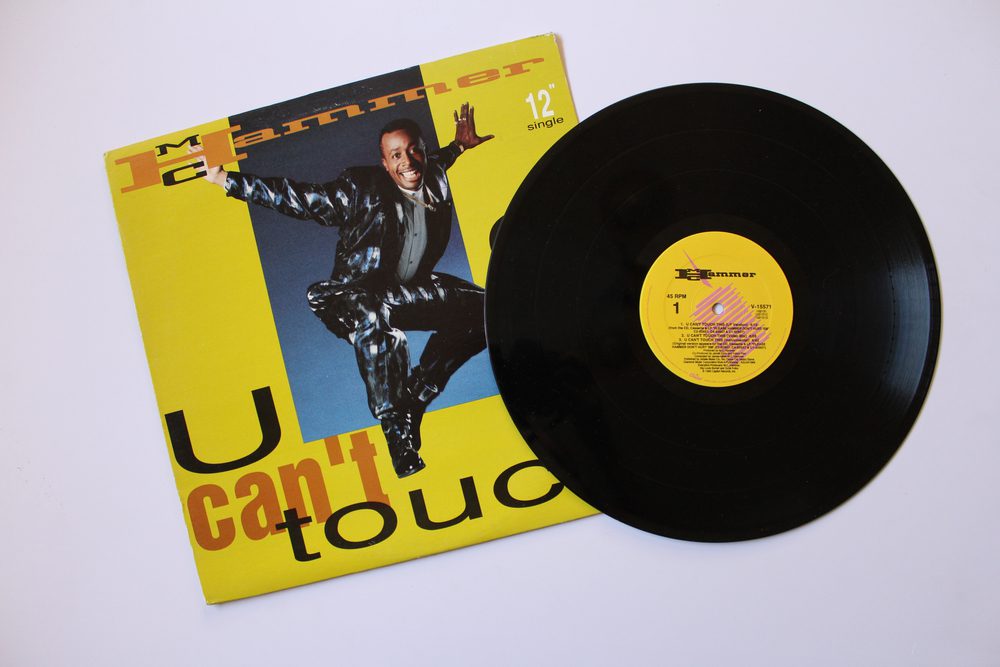
MC Hammer’s Please Hammer Don’t Hurt ’Em Goes Diamond: A Hip-Hop First
Cold Hard Platinum: April 15, 1991
On April 15, 1991, the Recording Industry Association of America (RIAA) made it official: Please Hammer Don’t Hurt ’Em had sold over 10 million copies in the United States. That Diamond certification didn’t just mark a career-defining moment for MC Hammer—it changed the trajectory of hip-hop’s relationship with the mainstream.
At the time, hitting Diamond status was an elite accomplishment, reserved primarily for rock, pop, and country juggernauts like Michael Jackson, The Beatles, and Garth Brooks. For a rap album to reach that tier was virtually unheard of. Please Hammer Don’t Hurt ’Em didn’t just join the club—it kicked the door open.
Hammer Time in the Mainstream
Released in February 1990, Please Hammer Don’t Hurt ’Em was built for mass appeal. It combined churchy optimism, family-friendly swagger, and pop-flavored beats that appealed far beyond hip-hop’s core audience.
The breakout single, “U Can’t Touch This,” flipped Rick James’ 1981 funk hit Super Freak into a hip-hop anthem. Hammer’s rhythmic delivery and kinetic choreography became unavoidable. MTV embraced the video, airing it in heavy rotation. Meanwhile, brands like Pepsi quickly tapped into his popularity.
Hammer wasn’t just making music—he was crafting a cultural moment, and Please Hammer Don’t Hurt ’Em became the sound of 1990.
Breaking the Genre Ceiling
When Hammer’s album hit Diamond, it shattered an invisible ceiling. Hip-hop, still seen by many in the industry as niche or fleeting, now had irrefutable commercial power.
Before Hammer, rap’s most significant commercial successes—Run-D.M.C.’s Raising Hell, the Beastie Boys’ Licensed to Ill, and LL Cool J’s Bigger and Deffer—had gone multi-platinum. But 10 million units? That was new territory. Hammer turned hip-hop into a household commodity, signaling to record labels and marketers that rap could scale globally.
It wasn’t just a personal win. It was a collective step forward for the genre.
Parachute into the sound of 1991—click here and feel the rhythm.
Tracklist That Touched Millions
“U Can’t Touch This”
This breakout hit turned MC Hammer into a global sensation. Built around the instantly recognizable bassline from Rick James’ Super Freak, it introduced a generation to hip-hop through catchy phrasing, clean lyrics, and signature dance moves. It earned Hammer a Grammy and became one of the decade’s most parodied—and played—tracks.
“Pray”
One of the album’s biggest follow-ups, “Pray” sampled Prince’s When Doves Cry and delivered a hopeful, gospel-influenced message. Its positive tone and catchy repetition helped it climb the charts, reinforcing Hammer’s family-friendly appeal without straying far from pop accessibility. Listen to Prince’s original song below.
“Have You Seen Her”
Hammer’s reinterpretation of the Chi-Lites’ classic added sentimental weight to the album. The track’s nostalgia resonated with older audiences while broadening his demographic beyond typical rap listeners. It became one of the album’s most radio-friendly singles.
“Help the Children”
Offering a socially conscious message, this song addressed poverty and youth violence in urban America. Its sincerity showed a different side of Hammer that aimed to uplift rather than entertain. Though not a major chart hit, it helped round out the album’s thematic depth.
“Dancin’ Machine”
A reimagining of the Jackson 5 song, “Dancin’ Machine” kept the energy high with funk-inspired rhythms and an infectious beat. It reinforced Hammer’s identity as a performer who thrived on movement and spectacle.
“Here Comes the Hammer”
Self-referential and brimming with bravado, this track amplified Hammer’s larger-than-life persona. With pounding beats and call-and-response chants, it was built for live performance and helped anchor his tour setlists.
“Yo!! Sweetness”
Laid-back and flirtatious, “Yo!! Sweetness” leaned into R&B stylings with a smoother delivery. Though not as prominent as the singles, it added variety to the album and showcased Hammer’s range beyond high-energy bangers.
“Crime Story”
This storytelling track dove into darker territory, recounting the consequences of crime with cinematic pacing. It stood in contrast to the album’s otherwise upbeat tone and showed Hammer’s willingness to explore serious themes.
“She’s Soft and Wet”
Inspired by Prince in both theme and style, this song explored sensuality with funk elements and a slow-groove vibe. It was an outlier among the hits, but offered yet another layer to Hammer’s stylistic diversity.
“Black Is Black”
Focused on Black pride and empowerment, this track tapped into cultural identity and social commentary. Though not a single, it resonated with listeners who saw Hammer as more than just a performer, but also as a voice of representation.
The Hammer Effect
Hammer didn’t just sell records—he sold an image. He was hip-hop’s first true multimedia star, from flashy parachute pants to lightning-quick footwork.
His Pepsi deal, sold-out tours, and expansive merchandising empire brought in millions. He was everywhere: cartoons, commercials, action figures. That visibility drew both praise and backlash. Critics accused him of watering down rap for white audiences and pushing “pop rap” over lyrical authenticity.
But no matter the critique, Hammer proved that a rapper could dominate global pop culture—on his terms.
Hammer Set the Bar…Then Danced Over It
MC Hammer’s Diamond certification marked a turning point. It showed hip-hop could sell at the highest level, breaking free from its underground label. After Hammer, labels became more willing to back rap artists with big budgets, national campaigns, and crossover ambitions.
Artists like Tupac, Eminem, OutKast, and Drake would eventually go on to match—and surpass—Hammer’s commercial reach. But he was the blueprint. And the debate he sparked—authenticity vs. accessibility—still defines the genre’s growing pains.
Can’t Touch That Milestone
April 15, 1991, is a date that belongs in hip-hop’s history books. It marked the moment the genre moved from the margins to the money.
Before billion-dollar moguls, Forbes lists, and Super Bowl halftime shows, there was Hammer—spinning, sliding, and selling 10 million copies. Whether you loved the pants or hated the hooks, there’s no denying it: Hammer changed the game.










